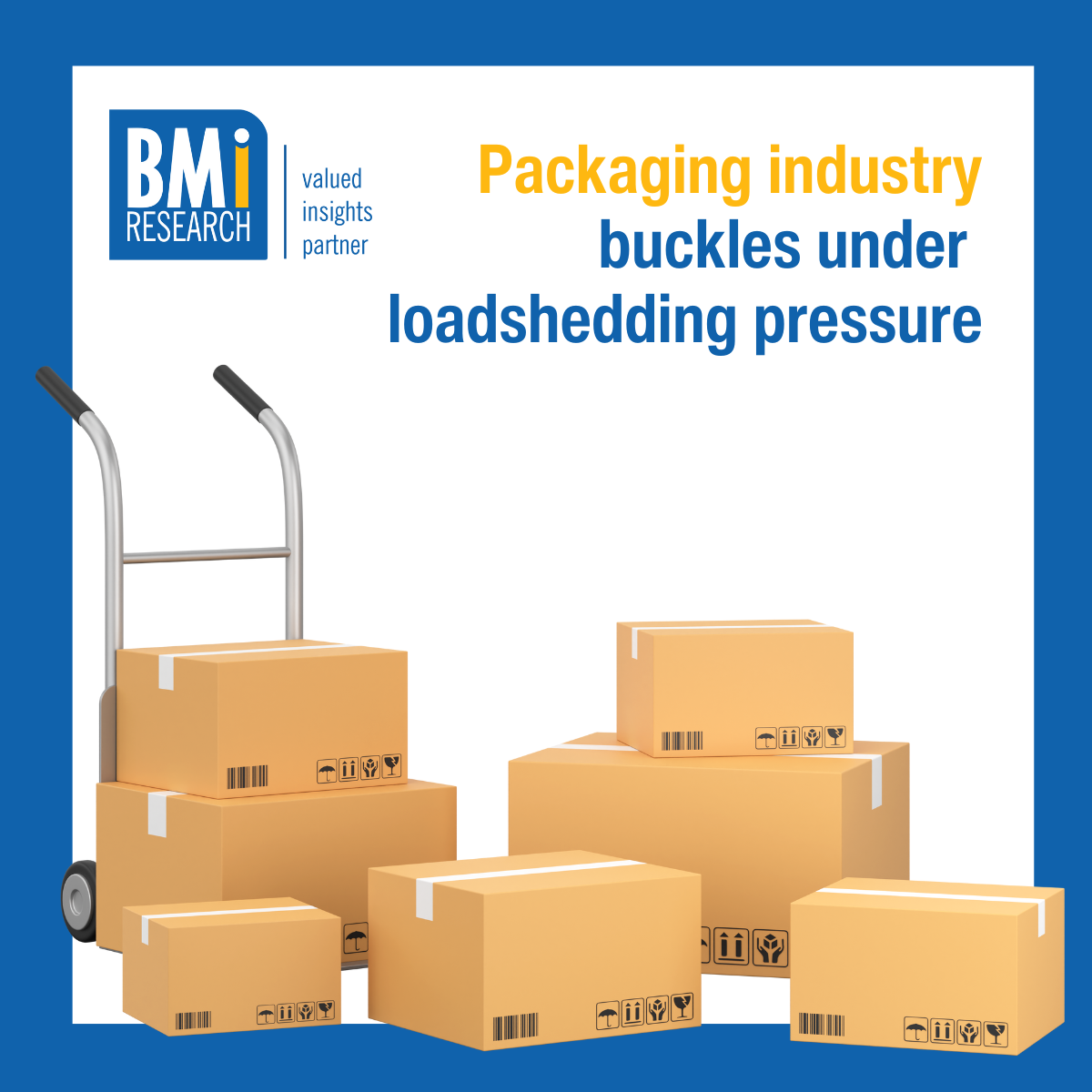
Packaging industry buckles under loadshedding pressure
Packaging industry buckles under loadshedding pressure
By Dr Dana Braithwaite, research consultant at BMi Research
The South African packaging industry is taking serious strain in the face of continued loadshedding. The latest Packaging Overview report from BMi Research shows that the sector is expected to record a 0.3% decline by the end of 2023.
The industry had barely recovered from the effects of the pandemic, when loadshedding returned in full force, at stage 6, in December 2022. Sustained loadshedding since then is having a negative impact at the most fundamental level – converters’ ability to operate and produce the packaging brand owners need.
To understand the true extent of the impact of the power crisis on the packaging industry, we need to first look back at those dark, uncertain days of the pandemic. At the height of the lockdowns, and in the months that followed, supply chains lengthened substantially. The time from ordering goods to delivery increased, even doubling in some cases, hampering converters’ abilities to fulfil their commitments to big brand manufacturers.
The outcome was that brands battled to get stock on retail shelves, which negatively impacted margins. As a direct result, manufacturers increased their supplier basket, signing up more converters to ensure a constant packaging supply.
They also rationalised their inventory, cutting underperforming lines and reducing the number of available variants and pack sizes. Lessened disposable income and consumers’ inability to afford certain products and pack sizes also played a role here.
Fast forward to the post-pandemic scenario, and manufacturers are skittish. Instead of reverting to their original packaging converters, they have retained their bigger supplier baskets, but are placing fewer orders across the spread of suppliers in order to maintain these contracts, should they suddenly need them again.
The effect of this is now starting to be felt by converters, two years later. That reduced demand and that rationalising is causing converters to cut product lines of their own. It has been a ripple effect of epic proportions.
But converters are not only rationalising on products, they’re rationalising on time as well because of loadshedding. Previously, decisions like cutting product lines were purely economic. Now, they’re driven by capacity.
In non-loadshedding times, when manufacturers required increased packaging products, converters would simply add an extra shift or work at night to up their capacity to meet increased demand. They were curtailed only by the limits of their staff or their machines.
Now, however, they can only work a certain number of hours per day. They can’t reclaim those hours lost to loadshedding. That time is gone, with the upshot being lessened capacity to meet manufacturers’ demand.
This too has had a knock-on effect: converters are now being expected to hold greater numbers of packaging stock for manufacturers to beat the loadshedding capacity drain. Increased stock holding necessitates more warehousing space, which is another cost converters have to absorb.
Some converters are investing in additional sites with larger capacity, but the majority of players are sinking capex into setting up alternative power systems, whether solar or generators, and spending large amounts of money on fuel just to keep the lights on. From the feedback received during the research, this is considered a better investment at this time, because brand new machinery is useless in the face of sustained loadshedding.
But this doesn’t grow industries. It actually has the opposite effect, as companies are spending money just to stay in business – a practice that in the ‘old days’ would have been considered bad business practice. Today, it is the new playing field.
The post-pandemic landscape and loadshedding are also making it more difficult for converters to make accurate forecasts. Annual price increases became monthly increases during the pandemic and are now quarterly adjustments, which, together with shorter timelines and an erosion of trust between players throughout the supply chain, has reduced their ability to predict market changes. Unreliable forecasts make it more difficult to run a profitable business.
This difficulty in predicting future changes was made abundantly clear in the last two months of 2023. The travel and trade restrictions of the pandemic had a negative impact on the already visible decline in port management in South Africa. The system never recovered and actually worsened after the restrictions were lifted, exacerbated by increased road traffic as rail capacity continued to decrease.
This led to increased congestion at ports, and sites such as Richards Bay – primarily built for rail cargo – had to adjust to the increased road traffic, with coal trucks blocking road infrastructure of local towns.
This issue is not limited to one port; maritime publications estimate that up to 71 000 containers at Durban Harbour are still waiting to be offloaded.
Brand owners have consistently said that the port equipment is not being maintained, leading to significantly lowered capacity. There appears to be no urgency to increase capacity or restore lost capacity by the authorities entrusted with this responsibility.
The final factor that has plagued the packaging industry is the fluctuations in the rand-dollar exchange rate. After the pandemic, when global currencies stabilised, international packaging markets reaped the benefits of that. But South Africa didn’t, as the rand continued to weaken. This has made South African packaging converters less competitive on the international stage.
On the plus side, there have been less company closures than one would have expected under these circumstances. Although where converters have closed their doors, the extra volume has been picked up, but sadly the employees have not.
Investors are also not completely put off by South Africa. There’s an understanding that conditions have to change, but this country is still considered one worth investing in. In fact, the packaging industry is expected to grow in the medium to long term, so that is a positive.
It’s difficult to know exactly what the next year will bring for the packaging industry, but one thing was clear from our research, South Africans have hope. And with hope, anything is possible.
The full report is available upon request. Please email [email protected]

